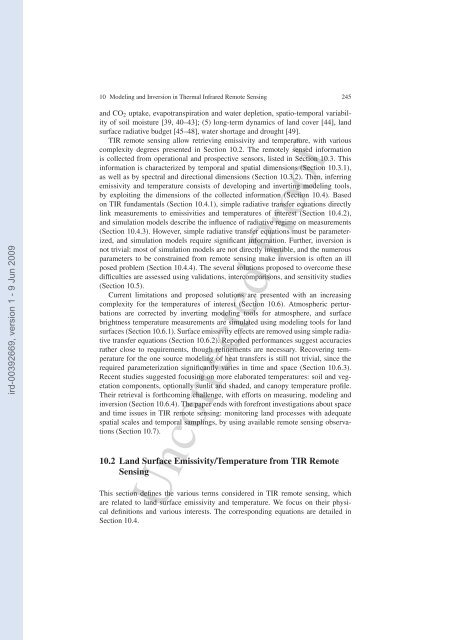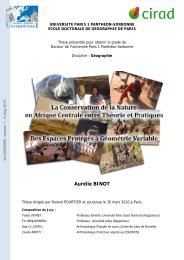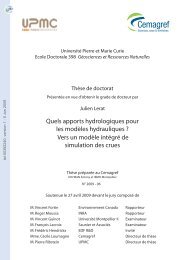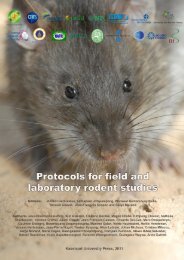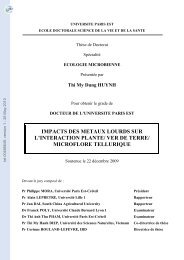Modeling and Inversion in Thermal Infrared Remote Sensing over ...
Modeling and Inversion in Thermal Infrared Remote Sensing over ...
Modeling and Inversion in Thermal Infrared Remote Sensing over ...
You also want an ePaper? Increase the reach of your titles
YUMPU automatically turns print PDFs into web optimized ePapers that Google loves.
10 <strong>Model<strong>in</strong>g</strong> <strong>and</strong> <strong>Inversion</strong> <strong>in</strong> <strong>Thermal</strong> <strong>Infrared</strong> <strong>Remote</strong> Sens<strong>in</strong>g 245ird-00392669, version 1 - 9 Jun 2009<strong>and</strong> CO 2 uptake, evapotranspiration <strong>and</strong> water depletion, spatio-temporal variabilityof soil moisture [39, 40–43]; (5) long-term dynamics of l<strong>and</strong> c<strong>over</strong> [44], l<strong>and</strong>surface radiative budget [45–48], water shortage <strong>and</strong> drought [49].TIR remote sens<strong>in</strong>g allow retriev<strong>in</strong>g emissivity <strong>and</strong> temperature, with variouscomplexity degrees presented <strong>in</strong> Section 10.2. The remotely sensed <strong>in</strong>formationis collected from operational <strong>and</strong> prospective sensors, listed <strong>in</strong> Section 10.3. This<strong>in</strong>formation is characterized by temporal <strong>and</strong> spatial dimensions (Section 10.3.1),as well as by spectral <strong>and</strong> directional dimensions (Section 10.3.2). Then, <strong>in</strong>ferr<strong>in</strong>gemissivity <strong>and</strong> temperature consists of develop<strong>in</strong>g <strong>and</strong> <strong>in</strong>vert<strong>in</strong>g model<strong>in</strong>g tools,by exploit<strong>in</strong>g the dimensions of the collected <strong>in</strong>formation (Section 10.4). Basedon TIR fundamentals (Section 10.4.1), simple radiative transfer equations directlyl<strong>in</strong>k measurements to emissivities <strong>and</strong> temperatures of <strong>in</strong>terest (Section 10.4.2),<strong>and</strong> simulation models describe the <strong>in</strong>fluence of radiative regime on measurements(Section 10.4.3). However, simple radiative transfer equations must be parameterized,<strong>and</strong> simulation models require significant <strong>in</strong>formation. Further, <strong>in</strong>version isnot trivial: most of simulation models are not directly <strong>in</strong>vertible, <strong>and</strong> the numerousparameters to be constra<strong>in</strong>ed from remote sens<strong>in</strong>g make <strong>in</strong>version is often an illposed problem (Section 10.4.4). The several solutions proposed to <strong>over</strong>come thesedifficulties are assessed us<strong>in</strong>g validations, <strong>in</strong>tercomparisons, <strong>and</strong> sensitivity studies(Section 10.5).Current limitations <strong>and</strong> proposed solutions are presented with an <strong>in</strong>creas<strong>in</strong>gcomplexity for the temperatures of <strong>in</strong>terest (Section 10.6). Atmospheric perturbationsare corrected by <strong>in</strong>vert<strong>in</strong>g model<strong>in</strong>g tools for atmosphere, <strong>and</strong> surfacebrightness temperature measurements are simulated us<strong>in</strong>g model<strong>in</strong>g tools for l<strong>and</strong>surfaces (Section 10.6.1). Surface emissivity effects are removed us<strong>in</strong>g simple radiativetransfer equations (Section 10.6.2). Reported performances suggest accuraciesrather close to requirements, though ref<strong>in</strong>ements are necessary. Rec<strong>over</strong><strong>in</strong>g temperaturefor the one source model<strong>in</strong>g of heat transfers is still not trivial, s<strong>in</strong>ce therequired parameterization significantly varies <strong>in</strong> time <strong>and</strong> space (Section 10.6.3).Recent studies suggested focus<strong>in</strong>g on more elaborated temperatures: soil <strong>and</strong> vegetationcomponents, optionally sunlit <strong>and</strong> shaded, <strong>and</strong> canopy temperature profile.Their retrieval is forthcom<strong>in</strong>g challenge, with efforts on measur<strong>in</strong>g, model<strong>in</strong>g <strong>and</strong><strong>in</strong>version (Section 10.6.4). The paper ends with forefront <strong>in</strong>vestigations about space<strong>and</strong> time issues <strong>in</strong> TIR remote sens<strong>in</strong>g: monitor<strong>in</strong>g l<strong>and</strong> processes with adequatespatial scales <strong>and</strong> temporal sampl<strong>in</strong>gs, by us<strong>in</strong>g available remote sens<strong>in</strong>g observations(Section 10.7).10.2 L<strong>and</strong> Surface Emissivity/Temperature from TIR <strong>Remote</strong>Sens<strong>in</strong>gThis section def<strong>in</strong>es the various terms considered <strong>in</strong> TIR remote sens<strong>in</strong>g, whichare related to l<strong>and</strong> surface emissivity <strong>and</strong> temperature. We focus on their physicaldef<strong>in</strong>itions <strong>and</strong> various <strong>in</strong>terests. The correspond<strong>in</strong>g equations are detailed <strong>in</strong>Section 10.4.Uncorrected Proof


